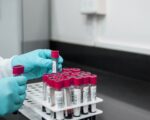NVision leverages new advances in quantum physics (the transformative features of nitrogen vacancies in diamonds) to fundamentally change molecular analysis and medical imaging. NVision is a developer of MRI polarizers and hyperpolarized imaging agents. The company’s hyperpolarization technology permits the assessment of human and animal metabolism by standard MRI, enabling advanced preclinical and clinical applications, including novel cancer diagnosis and monitoring of response to therapy.
NVision is enabling room-temperature hyperpolarization in 3 minutes based on parahydrogen-induced polarization (PHIP) by combining deep expertise in spin quantum physics, chemistry and engineering. On the one hand, the collaborators exploited the special quantum sensing properties of nitrogen-vacancy centres (NV centres) in nanostructured diamond to detect NMR signals with 1000-fold better spatial resolution, compared to the current state of the art, proving that microscopic spectroscopy is suitable for metabolic analyses on single cells. On the other hand, the researchers successfully demonstrated for the first time that a PHIP quantum polarizer is feasible for high-sensitivity preclinical in vivo studies, demonstrating hyperpolarized magnetic resonance imaging under real-world conditions.
NVision realized the prototype quantum microscope based on the characterized nano diamond chips and demonstrated in feasibility studies both hyperpolarization using optically polarized electron spins in diamond and detection of hyperpolarized metabolites at high spectral resolution. Bruker BioSpin GmbH was responsible for evaluating the samples from NVision to determine the spin concentration and relaxation time. With the setup, the collaborative demonstrated NMR spectroscopy on metabolites on a microscopic scale for the first time.
Hyperpolarizing techniques magnetically align a large fraction of the nuclear spins for a certain period of time, which increases the strength of the NMR signal by several orders of magnitude. Therefore, with an NMR signal amplified 100,000-fold by hyperpolarization, medical applications such as MRI can be improved many times over. Cardiovascular diseases could be diagnosed much earlier, cancer therapies could be immediately tested for their effect and thus be personalized since physicians are able to detect typical metabolic processes at the molecular level in real-time.











